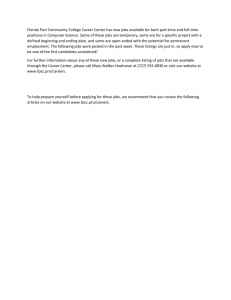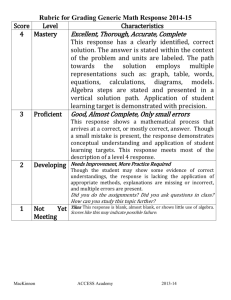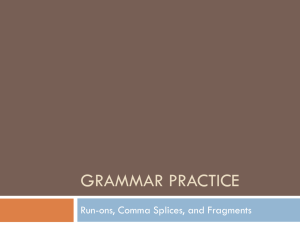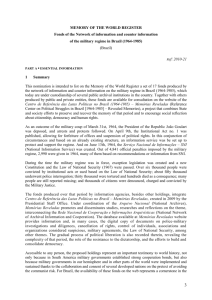Exercise 7 - Portal del DMT
advertisement
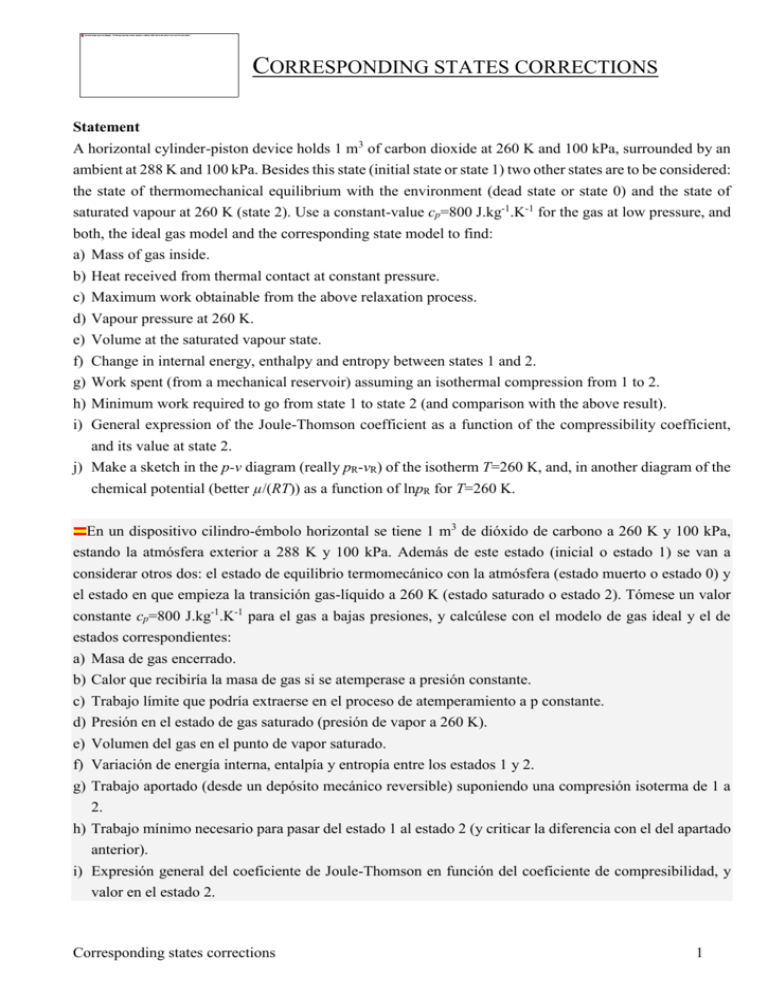
CORRESPONDING STATES CORRECTIONS Statement A horizontal cylinder-piston device holds 1 m3 of carbon dioxide at 260 K and 100 kPa, surrounded by an ambient at 288 K and 100 kPa. Besides this state (initial state or state 1) two other states are to be considered: the state of thermomechanical equilibrium with the environment (dead state or state 0) and the state of saturated vapour at 260 K (state 2). Use a constant-value cp=800 Jkg-1K-1 for the gas at low pressure, and both, the ideal gas model and the corresponding state model to find: a) Mass of gas inside. b) Heat received from thermal contact at constant pressure. c) Maximum work obtainable from the above relaxation process. d) e) f) g) h) i) Vapour pressure at 260 K. Volume at the saturated vapour state. Change in internal energy, enthalpy and entropy between states 1 and 2. Work spent (from a mechanical reservoir) assuming an isothermal compression from 1 to 2. Minimum work required to go from state 1 to state 2 (and comparison with the above result). General expression of the Joule-Thomson coefficient as a function of the compressibility coefficient, and its value at state 2. j) Make a sketch in the p-v diagram (really pR-vR) of the isotherm T=260 K, and, in another diagram of the chemical potential (better µ/(RT)) as a function of lnpR for T=260 K. En un dispositivo cilindro-émbolo horizontal se tiene 1 m3 de dióxido de carbono a 260 K y 100 kPa, estando la atmósfera exterior a 288 K y 100 kPa. Además de este estado (inicial o estado 1) se van a considerar otros dos: el estado de equilibrio termomecánico con la atmósfera (estado muerto o estado 0) y el estado en que empieza la transición gas-líquido a 260 K (estado saturado o estado 2). Tómese un valor constante cp=800 Jkg-1K-1 para el gas a bajas presiones, y calcúlese con el modelo de gas ideal y el de estados correspondientes: a) Masa de gas encerrado. b) Calor que recibiría la masa de gas si se atemperase a presión constante. c) Trabajo límite que podría extraerse en el proceso de atemperamiento a p constante. d) Presión en el estado de gas saturado (presión de vapor a 260 K). e) Volumen del gas en el punto de vapor saturado. f) Variación de energía interna, entalpía y entropía entre los estados 1 y 2. g) Trabajo aportado (desde un depósito mecánico reversible) suponiendo una compresión isoterma de 1 a 2. h) Trabajo mínimo necesario para pasar del estado 1 al estado 2 (y criticar la diferencia con el del apartado anterior). i) Expresión general del coeficiente de Joule-Thomson en función del coeficiente de compresibilidad, y valor en el estado 2. Corresponding states corrections 1 j) Representar esquemáticamente en un diagrama p-v (en realidad pR-vR) la isoterma T=260 K, y en otro diagrama el potencial químico, en realidad µ/(RT), en función de lnpR para T=260 K, para los tres casos siguientes: 1) para el modelo de gas ideal (completado con el de líquido incompresible a partir del punto bifásico), 2) para el modelo de estados correspondientes, 3) para el modelo de van der Waals reducido, dando en este último caso las expresiones explícitas µ(vR) y pR(vR). Solution. We use the perfect gas model (PGM), or the corresponding state model (CSM) when needed, with constant thermal capacity in both cases (in the ideal gas limit (p0) cp varies almost linearly (e.g. cp=753 J/(kg·K) at the triple-point temperature, Ttr=216 K, and cp=850 J/(kg·K) at the triple-point temperature, Tcr=304 K). Figure 1 is a sketch in the Z-p diagram of the three states mentioned. Fig. 1. State points in the corresponding states diagrams. a) Mass of gas inside. With the PGM, m=pV/(RT)=105∙1/(189·260)=2.04 kg, with RCO2=(8.3/0.044=189 J/(kg·K). With the CSM: pV 105 1 m 2.06 kg ZRT 0.99 189 260 b) c) d) e) where the compressibility factor Z has been obtained from the corresponding state diagram, at state 1, Z(pR1,TR1)=Z(0.1/7.4;260/304)=Z(0.01;0.85)=0.99. In this state, the density correction by nonideality (compressibility correction) is very small, always increasing the ideal-gas value (for temperatures below Boyle's temperature, TBoyle2.5Tcr). Heat received from thermal contact at constant pressure. Q=H=m(hidh0cc+h1cc)mhid=mcp(T0-T1)=2.06800(288260)=46 kJ, since enthalpy corrections for compressibility were very small. It may be compared with the best value available (NIST) Q=m(h0h1)=47.6 kJ. Maximum work obtainable from the above relaxation process. Wmin==(U+p0V-T0S)=35+1049=4 kJ (i.e. up to 4 kJ of work could have been obtained), since energy corrections (U=HpV, U=HZ1RT) and entropy corrections were very small, and U=mcv(T0-T1)=2.06∙8008.3/0.044)∙(288260)=35 kJ, p0V=mRT=2.06·189·(288260) =10 kJ, and S=mcpln(T0/T1)mRln(p0/p1) =2.06∙800∙ln(288/260)=169 J/K. Vapour pressure at 260 K. The ideal gas model cannot condense, and thence there is no relation to equilibrium vapour pressure. From the corresponding states diagram Z-pR, the liquid-vapour-equilibrium at TR=0.85 is pR,vap=0.32, thus pv2=2.36 MPa (the more-accurate Antoine's correlation gives 2.42 MPa). It may be compared with the best value available (NIST) pv2=2.416 MPa. Volume at the saturated vapour state. Corresponding states corrections 2 With the ideal gas model, V2=mRT/p=2.04∙189∙260/(2.42∙106)=0.042 m3, although it is more accurate to directly compute V2 from Boyle's law: at constant temperature, V2=V1p1/p2=1.105/(2.42.106)=0.041 m3 . With the corresponding states model: V f) ZmRT 0.77 2.06 189 260 0.032 m3 6 p 2.36 10 where the compressibility factor Z has been obtained from the corresponding state diagram: Z(pR2,TR2)=Z(2.36/7.4;260/304)=Z(0.33;0.85)=0.77. Change in internal energy, enthalpy and entropy between states 1 and 2. As usual, we compute energy changes in terms of enthalpy changes, because only enthalpy data are usually available. U=H(p2V2p1V1), H=m(hidh2cc+h1cc), S=m(sids2cc+s1cc). With the corresponding-state-correction diagram for enthalpy (see Thermal Data) one finds h2cc/(RTcr)=0.6 (or h2cc/Tcr=5 J/(mol∙K)), and similarly s2cc/R=0.6 (or s2cc=5 J/(mol∙K)), thence h2cc=5∙304/0.044=35 kJ/kg and s2cc=110 J/kg. Corrections at state 1 are negligible, thus we have H=m(cpTh2cc+h1cc)=2.06∙(0=72 kJ, S=m(cpln(T2/T1)Rln(p2/p1) s2cc+s1cc) g) h) i) =2.06∙(0(8.3/0.044)∙ln(2.36/0.1)=1.5 kJ/K, and U=H(p2V2p1V1)= =72(2360∙0.032100∙1)=48 kJ. These values may be compared with the best value available (NIST): H=78.9 kJ, S=1.46 kJ/K, and U=56 kJ. Work spent (from a mechanical reservoir) assuming an isothermal compression from 1 to 2. With the CSM, Wu12=W12+p0(V2-V1)=E2-E1-Q12+p0(V2-V1)=E2-E1-T2(S2-S1)+p0(V2-V1)=200 kJ (with the PGM Wu12=220 kJ). Minimum work required to go from state 1 to state 2 (and comparison with the above result). Wu12min=E2-E1+p0(V2-V1)T0(S2-S1)=240 kJ by the CSM. Question. How can the minimum be larger than the actual? The answer lies in the fact that, for the actual work, we have used a second heat source (at 260 K) that brings in extra exergy. General expression of the Joule-Thomson coefficient as a function of the compressibility coefficient, and its value at state 2. From the definition of Joule-Thomson or Joule-Kelvin coefficient, JK: JK T p h ZRT 1 Z (1 T )v , with v and p cp Z T p 1 T , i.e. JK p T Z From the corresponding states diagram we can graphically evaluate T 2=0.021 K/Pa. Of course, with the PGM JK=0, since =1/T. j) h RT 2 Z c p p T p =2.6 K-1, and thence JK p Make a sketch in the p-v diagram (really pR-vR) of the isotherm T=260 K, and, in another diagram, of the chemical potential µ, or better µ/(RT) to be dimensionless, as a function of lnpR for T=260 K (recall that for pure substances the chemical potential coincides with Gibbs potential g(T,p)). Corresponding states corrections 3 Instead of the CSM we use the PGM and the reduced van-der-Waals's model (vWRM), pR 8TR 3 2 , to work analytically (instead of graphically). The PGM with vcr based on vWM, 3vR 1 vR reduces to pR 8TR , what yields the plot: 3vR Fig. 2. The reduced isotherm T=260 K (TR=0.85) in the reduced p-v diagram, for both the ideal gas model and for the reduced van der Waals model. The chemical potential µ, must be obtained from dµ=sdT+vdp dµ=vdp along an isotherm, and we want to plot T , p RT T , p 0 RT p vdp , not an easy task since we do not have v(p) but RT p 0 p(v); proceeding in parametrics, i.e. computing µ(v) and p(v), one finally gets (details aside): Fig. 3. The reduced isotherm T=260 K (TR=0.85) in the reduced /(RT)-lnp diagram, for the ideal gas model (PGM) and for the reduced van der Waals model (VWM). Comments. The vapour pressure at this temperature may be found by Maxwell's rule (it coincides with the crossing point in the /(RT)-lnp diagrams). Back Corresponding states corrections 4
